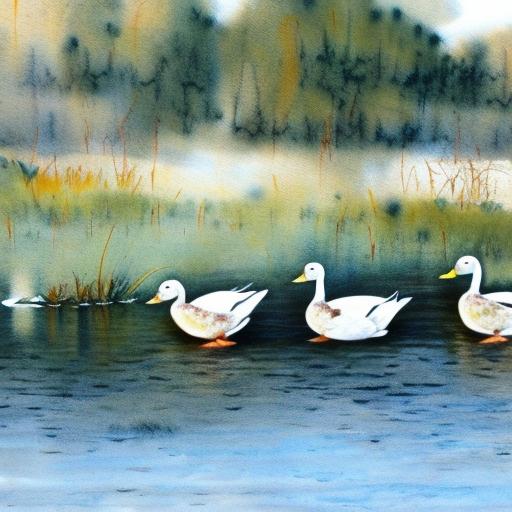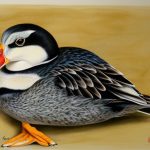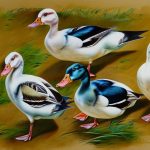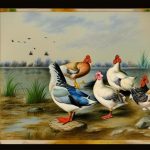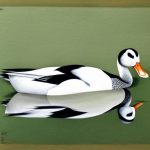Duck breeding is an important aspect of duck farming and conservation efforts. Ducks are popular for their meat, eggs, and feathers, making them a valuable resource for farmers and wildlife enthusiasts alike. Breeding ducks can be a rewarding experience, but it requires careful planning and management to ensure the health and productivity of the flock. Understanding the mating behavior, age of sexual maturity, environmental factors, breeding seasons, nesting habits, and conservation efforts are all crucial aspects of successful duck breeding. By delving into these topics, duck breeders can optimize their breeding programs and contribute to the preservation of duck populations in the wild.
Duck breeding is a complex process that involves various factors such as genetics, nutrition, and environmental conditions. Whether breeding ducks for commercial purposes or conservation efforts, it is essential to have a comprehensive understanding of the breeding behavior and requirements of ducks. This article will explore the intricacies of duck breeding, providing valuable insights for both novice and experienced breeders. From the mating behavior of ducks to the conservation and management of breeding populations, each aspect plays a crucial role in the success of duck breeding programs.
Key Takeaways
- Duck breeding involves the process of mating, egg laying, and nesting habits of ducks.
- Ducks exhibit complex mating behaviors, including courtship displays and pair bonding.
- Ducks reach sexual maturity at different ages depending on the species, with some reaching maturity in their first year.
- Environmental factors such as temperature, daylight length, and food availability can affect duck breeding.
- Different duck species have specific breeding seasons, with some breeding in the spring and others in the fall.
Mating Behavior of Ducks
The mating behavior of ducks is an intriguing aspect of their reproductive cycle. Ducks are known for their elaborate courtship displays, which often involve intricate movements, vocalizations, and plumage displays. Male ducks, known as drakes, will often engage in competitive displays to attract females and establish dominance within a group. These displays can include head bobbing, tail wagging, and vocal calls to impress potential mates. Once a pair has formed, they will engage in preening each other’s feathers and engaging in mutual grooming behaviors as a form of bonding.
In addition to courtship displays, ducks also engage in elaborate mating rituals that involve synchronized movements and vocalizations. These rituals serve to strengthen the bond between mates and ensure successful reproduction. The mating behavior of ducks is a fascinating display of natural instincts and social dynamics within a flock. Understanding these behaviors is essential for breeders to create optimal conditions for successful mating and reproduction within their flocks.
Age of Sexual Maturity in Ducks
The age of sexual maturity in ducks varies depending on the species and individual genetics. In general, most duck species reach sexual maturity between 5-7 months of age. However, some larger breeds may take longer to reach maturity, while smaller breeds may mature more quickly. It is important for breeders to be aware of the specific maturity timeline for their chosen duck species to ensure proper breeding management.
Factors such as nutrition, housing conditions, and overall health can also influence the age at which ducks reach sexual maturity. Providing a balanced diet rich in essential nutrients and maintaining a clean and stress-free environment can help promote healthy growth and development in young ducks. Breeders should closely monitor the growth and development of their ducks to identify signs of sexual maturity and prepare for the breeding season accordingly.
Environmental Factors Affecting Duck Breeding
Environmental factors play a significant role in the success of duck breeding. Ducks are highly sensitive to their surroundings, and changes in temperature, humidity, and daylight can impact their reproductive behaviors. Adequate housing, access to clean water, and proper ventilation are essential for creating a conducive environment for duck breeding. Additionally, natural habitats such as wetlands and ponds provide ideal conditions for wild duck populations to engage in natural breeding behaviors.
In commercial duck farming, environmental factors such as lighting and temperature control are crucial for stimulating reproductive activity in ducks. By mimicking natural daylight cycles and providing optimal temperature conditions, breeders can encourage ducks to enter into the breeding season. Understanding the impact of environmental factors on duck breeding is essential for creating a sustainable and productive breeding program.
Breeding Season for Different Duck Species
The breeding season for different duck species can vary based on geographic location, climate, and environmental conditions. In general, most duck species breed during the spring and summer months when food sources are abundant, and nesting sites are readily available. However, some species may have specific breeding seasons based on their migratory patterns or habitat preferences.
For example, dabbling ducks such as mallards and teal typically breed in shallow wetlands and marshes during the spring months. Diving ducks such as canvasbacks and scaup may have a later breeding season due to their preference for deeper water habitats. Understanding the specific breeding season for each duck species is essential for managing breeding programs and conserving wild populations.
Nesting and Egg Laying Habits of Ducks

Nesting and egg laying habits are critical aspects of duck breeding. Female ducks will seek out suitable nesting sites near water sources, where they will construct nests using grasses, reeds, and other natural materials. The location and construction of the nest are essential for protecting the eggs from predators and providing a safe environment for incubation.
Once the nest is complete, female ducks will lay a clutch of eggs over several days, typically laying one egg per day until the clutch is complete. The number of eggs in a clutch can vary depending on the species, with some ducks laying as few as 6-8 eggs while others may lay up to 12-15 eggs. After the clutch is complete, the female will begin incubating the eggs, using her body heat to keep them warm until they hatch.
Understanding the nesting and egg laying habits of ducks is crucial for breeders to provide appropriate nesting materials and nesting sites for their flocks. By creating a safe and comfortable environment for nesting, breeders can help ensure the successful hatching and rearing of ducklings.
Conservation and Management of Duck Breeding Populations
Conservation and management efforts play a vital role in preserving duck breeding populations in the wild. Habitat loss, pollution, hunting pressure, and climate change are all significant threats to duck populations worldwide. Conservation organizations work tirelessly to protect critical habitats, implement sustainable hunting practices, and raise awareness about the importance of preserving duck populations for future generations.
In addition to conservation efforts in the wild, captive breeding programs also play a crucial role in maintaining genetic diversity and ensuring the long-term survival of endangered duck species. By carefully managing breeding pairs and implementing genetic diversity programs, captive breeding facilities can contribute to the overall health and resilience of duck populations.
Overall, conservation and management efforts are essential for safeguarding the future of duck breeding populations. By working together to address threats to duck populations and implementing sustainable management practices, we can ensure that ducks continue to thrive in both natural and captive environments.
In conclusion, duck breeding is a multifaceted endeavor that requires careful consideration of mating behavior, sexual maturity, environmental factors, breeding seasons, nesting habits, and conservation efforts. By understanding these key aspects of duck breeding, breeders can optimize their breeding programs for success while contributing to the preservation of duck populations worldwide. Whether for commercial purposes or conservation efforts, responsible duck breeding practices are essential for ensuring the health and sustainability of duck populations now and in the future.
If you’re curious about when ducks start breeding, you might also be interested in learning about the best practices for keeping chickens. Poultry Wizard offers valuable insights into chicken care, including tips for building a chicken coop in Grand Island, NE (source) and Chester, SC (source). Understanding the breeding habits of ducks and the proper care of chickens can help you create a thriving poultry environment.
FAQs
What age do ducks start breeding?
Ducks typically reach sexual maturity and start breeding at around 5-6 months of age.
What time of year do ducks start breeding?
Ducks generally start breeding in the spring, typically between March and May, when the weather is warmer and food sources are more abundant.
How do ducks choose a mate?
Ducks often engage in courtship displays, where the males will perform elaborate behaviors to attract a mate. Once a pair has formed, they will often stay together for the breeding season.
How many eggs do ducks lay when breeding?
The number of eggs a duck will lay during breeding season can vary, but it is common for ducks to lay anywhere from 8 to 12 eggs in a clutch.
How long does it take for duck eggs to hatch?
Duck eggs typically take around 28 days to hatch, although this can vary slightly depending on the specific species of duck.
Meet Walter, the feathered-friend fanatic of Florida! Nestled in the sunshine state, Walter struts through life with his feathered companions, clucking his way to happiness. With a coop that’s fancier than a five-star hotel, he’s the Don Juan of the chicken world. When he’s not teaching his hens to do the cha-cha, you’ll find him in a heated debate with his prized rooster, Sir Clucks-a-Lot. Walter’s poultry passion is no yolk; he’s the sunny-side-up guy you never knew you needed in your flock of friends!

